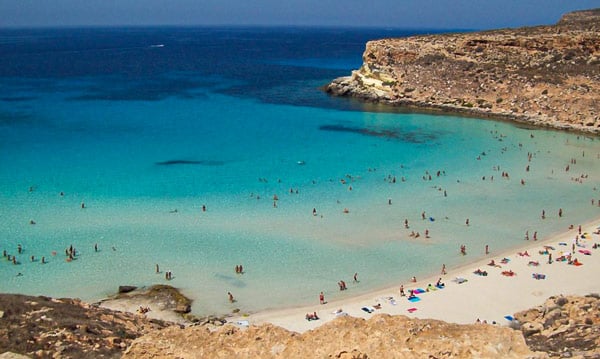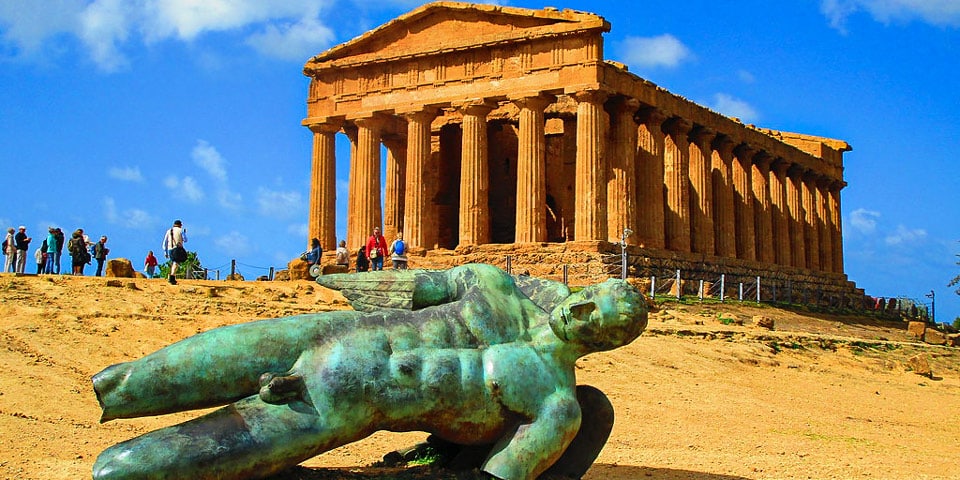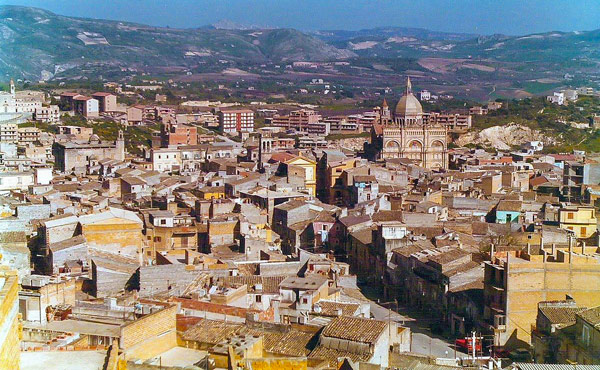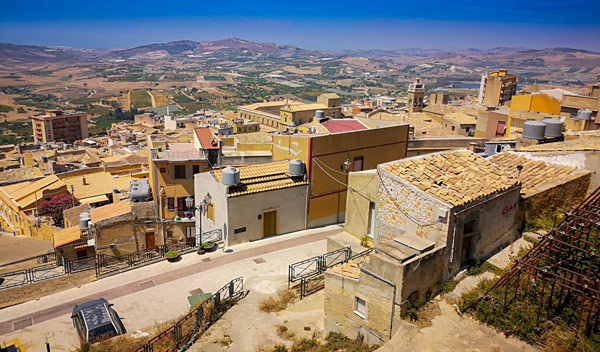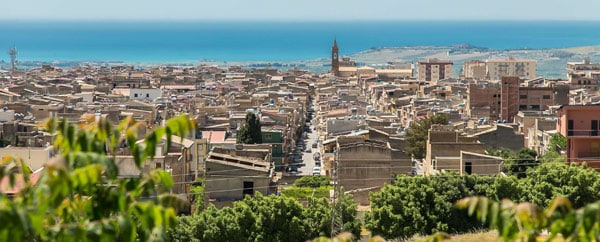Agrigento
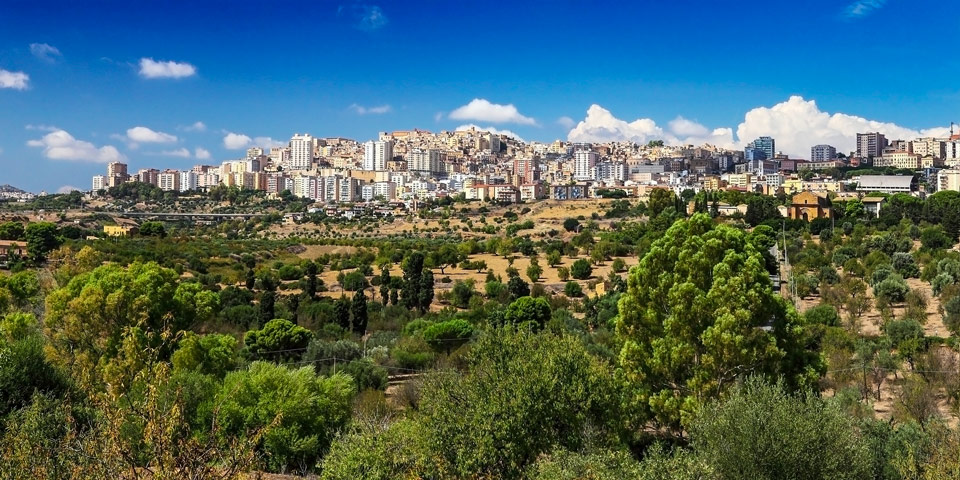
Agrigento, a city and province in southern Sicily (Sicilia), boasts a long history. People have lived here since the Copper-Stone Age, and the ancient Greeks established a powerful state.
The area’s prosperity is evidenced by ancient temples, castles, palaces, and amphitheaters.
Page Contents
Geography
Agrigento is located on the southeastern coast of Sicily. To the north, the area is bordered by the Sicani Mountains (Monti Sicani), so much of the region is hilly. The highest peak, Monte delle Rose, is 4,711 feet (1436 meters). Primrose, hawthorn, and orchids grow here. An ancient necropolis from the 8th century BC is situated on the slopes.
On the eastern border flows Sicily’s largest river, the Salso, and on the western border, the Belice.
Despite this, the island is not known for its abundant water resources, so locals rely on imported water.
The reservoirs within Agrigento’s territory—Lake Magazzolo, Orange Lake, and the San Giovanni dam—partially address the city’s water issue.
Check out our editorial selection of the best hotels in Agrigento.
Islands
The province includes the Pelagie Islands (Isole Pelagie), Italy’s southernmost archipelago, located near Africa between Malta and Tunisia.
It consists of three volcanic islands – Lampedusa, Linosa, and Lampione. The first two are inhabited, while the last is uninhabited. No rivers or lakes are on the islands, so rain is the only source of fresh water.
The unique marine fauna and favorable climate attract many tourists here. Loggerhead turtles live and lay their eggs here.
Administrative Division
Agrigento was a province until 2015. Then it gained autonomy, and the region acquired the status of the Free Municipal Consortium of Agrigento (Libero consorzio comunale di Agrigento).
The area consists of 43 municipalities, home to over 435,000 people. The capital, the city of Agrigento, was one of the main colonies of Ancient Greece in antiquity and today has about 60,000 inhabitants.
Check out the section: major cities of Italy.
Climate
Agrigento is one of the warmest regions in Sicily, but it doesn’t experience the extreme weather conditions found in other parts of the island during heatwaves. In winter, the temperature rarely drops below 45°F (7°C), while in summer, it typically hovers around 81°F (27°C).
Average Temperature in Agrigento by Month
| Month | Min / Max, °F (°C) |
|---|---|
| January | 46° / 57° (8° / 14°) |
| February | 46° / 58.1° (8° / 14.5°) |
| March | 48.2° / 60.8° (9° / 16°) |
| April | 51.8° / 66.2° (11° / 19°) |
| May | 57.2° / 75.2° (14° / 24°) |
| June | 66.2° / 82.4° (19° / 28°) |
| July | 69.8° / 86° (21° / 30°) |
| August | 71.6° / 87.8° (22° / 31°) |
| September | 66.2° / 82.4° (19° / 28°) |
| October | 60.8° / 75.2° (16° / 24°) |
| November | 53.6° / 66.2° (12° / 19°) |
| December | 48.2° / 60.8° (9° / 16°) |
Capital’s Attractions
Agrigento was founded in the 6th century BC. The historical center is located on the west side of the Girgenti hill. Ancient churches, monasteries, palaces, and fragments of city walls have been preserved. At the Bonamorone cemetery (Cimitero di Bonamorone) are tombs, statues, chapels from past centuries, and a temple dedicated to soldiers who died in the two world wars.
Agrigento has many houses built in the Arab-Norman art style:
- The Seminary Building (Seminario Arcivescovile Agrigento).
- The Bishop’s Palace (Palazzo Vescovile).
- The Monumental Complex of Santo Spirito (complesso monumentale di Santo Spirito).
The city’s main attraction is the Valley of the Temples (Valle dei Templi), which spans over 1,300 hectares.
Here, you’ll find remnants of ancient city walls, gates, an ancient necropolis, theaters, and sacred buildings dedicated to Zeus, Hera Lacinia, Hercules, and other gods and heroes.
Read the article about all the attractions in Agrigento
TOP 6 Temples of Agrigento
- Cathedral of San Gerlando – the city’s main church.
- Sanctuary of San Calogero. A 13th-century basilica dedicated to the patron of Agrigento. Inside are mosaics, an altar, and wooden statues from the 16th century.
- Sanctuary of the Mother of 7 Sorrows. Built into a limestone cliff by Sicilian workers, its cellars contain crypts.
- Basilica of the Immaculate Conception. The church is renowned for its beautiful interior, which includes marble tombs of nobles and clergymen.
- Church of Saint Mary of the Greeks. A 12th-century building erected on the foundations of a Doric temple.
- Basilica of Saint Nicholas. A 12th-century church in the Valley of the Temples allows visitors to explore Christian and ancient structures.
Regional Attractions
The region boasts many national monuments, including ancient cemeteries, classical and Christian temples, and the homes of notable individuals.
Bivona
The main attraction of Bivona is the Castello di Bivona, a castle built in the 14th century.
The town, located 39 miles (63 km) north of Agrigento, is filled with temples, monasteries, and medieval towers.
Favara
In Favara, be sure to visit the Chiaramonte Castle (Castello di Chiaramonte), the Church of Mother Madonna Assunta (La chiesa madre-Madonna Assunta), and the Church of the Most Holy Rosary (Chiesa del Santissimo Rosario).
Favara is located about 6 miles (10 km) west of Agrigento.
Naro
The main attractions in Naro are the Norman Cathedral (Duomo di Normanno) and the medieval fortress (Castello di Naro).
Naro is situated 17 miles (28 km) west of Agrigento.
Ribera
In Ribera, you can find the ruins of Poggiodiana Castle (Castello di Poggiodiana) and the Anguilla necropolis (La necropoli Anguilla), where tombs and burial chambers from the Bronze Age have been discovered.
Ribera is located about 32 miles (51 km) northeast of Agrigento.
Protected Areas
- The Mouth of the Platani River (Riserva naturale orientata Foce del fiume Platani) attracts tourists with its beaches and Mediterranean vegetation.
- Monti Sicani Reserve (Parco dei Monti Sicani). This area contains Paleozoic fossils, is home to over 60 bird species, and boasts a variety of plants, including orchids.
- The Mouth of the Belice River and Adjacent Dunes (Riserva naturale Foce del Fiume Belice e dune limitrofe). Visitors can observe birds, lizards, and wetland vegetation, wander through sand dunes, and relax by the lake.
Top 3 Beaches
Agrigento, with its access to the Mediterranean Sea, has many beaches. According to tourist reviews, the best are:
- Siculiana Marina Beach (Spiaggia di Siculiana Marina) is an hour’s drive from Agrigento. It features shallow waters, clear water, a combination of white cliffs, sand, and pebbles. The shore offers good service and parking.
- The beach in the Punta Bianca Natural Reserve (Riserva Naturale di Punta Bianca). Go here if you have plenty of time and love taking beautiful photos. The coastline of white limestone makes the water dazzlingly blue. The drive from Agrigento takes 40 minutes, but the road is in poor condition.
- Capo Rossello Beach (Spiaggia di Capo Rossello) is located 15.5 miles (25 km) from Agrigento. It’s suitable for families with small children – the sea is clean and shallow, with views of white stone cliffs and the Turkish steps. The beach has toilets, showers, sun loungers, and cafes.
See the list of the best beaches near Agrigento.
Holidays
Sicilians love to celebrate, infusing their festivals with ancient Sicilian folklore. Special attention is given to Saint Calogero, the patron of Agrigento, the regional capital. Festivals and costumed parades occur annually from July 6 to July 14. During the procession, bread is offered to the saint, which is thrown towards his statue.
Another festival dedicated to Calogero occurs in Naro from June 15 to June 25, ending on the saint’s death anniversary. The martyr’s statue is placed on wooden sleds and dragged through the city on ropes from the church of Saint Calogero to the Mother Church (Chiesa Madre).
On May 5, the residents of Licata (Licata) celebrate the day of Saint Angelo Carmelita (Angelo da Gerusalemme). A bustling fair opens several days before the event until May 6. Barefoot sailors carry a 17th-century silver urn on their shoulders.
The Festival of Saint Rosalia in Bivona takes place from September 3 to September 5, a tradition since 1624. A large procession moves through the streets, with musicians playing in the alleys. The festivities conclude with a grand fireworks display.
Although Saint Antonius is the patron of Favara, the main festival is dedicated to Joseph, Mary’s husband. At the turn of August to September, a feast featuring traditional soup with various types of pasta and vegetables is celebrated.
Winemaking
In a cave near Agrigento, archaeologists discovered remnants of the world’s oldest wine. They found a vessel and determined that the beverage inside dates back to the 4th millennium BC.
Winemaking continues to receive significant attention today. If you plan a wine tour in the region, consider visiting these wineries:
- Planeta Winery (Planeta Dispensa). This family business started in 1900. Now, Planeta is a large international company with vineyards covering 865 acres (350 hectares) in four areas of Sicily – Noto, Vittoria, Sambuca di Sicilia, and Menfi. Their most famous wines include Burdese, Sito dell’Ulmo Merlot, and Maroccoli Syrah. Address: Contrada Dispensa, 92013 Menfi AG.
- Organic farm Bagliesi in Ravanusa. The company produces white, red, and rosé native wine varieties – Maior, Syrah, Scualusu rosso or bianco, Kammut, VB59, Catarratto, Grillo.
- Cantina Di Giovanna winery. The vineyards are located on the slopes of the Monte Genuardo nature reserve in the municipality of Sambuca di Sicilia. The first plantings date back to 1860. The company produces both native and international wine varieties – Chardonnay, Grillo, Grecanico, Catarratto, Sauvignon Blanc, and others.
- Feudo Arancio Winery. Established in 2001 and part of the Mezzacorona group, Feudo Arancio released its first Sicilian wines under its label in 2003 – Grillo, Inzolia, Chardonnay, Hepo d’Abola, Syrah, Merlot.
How to Get There
The region has no airports except for Lampedusa Airport (Aeroporto di Lampedusa), located on the Pelagie Islands. Alternatively, you can fly into Palermo, the capital of Sicily. You can reach Agrigento by train, car, or bus from there.
Read how to get from Palermo airport to the city center here.
Railways
The region is crossed by three railway lines:
- Palermo-Agrigento.
- Caltanissetta Xirbi-Agrigento.
- Syracuse-Canicattì (Siracusa-Canicattì).
The main station in the area, Stazione di Agrigento Centrale, is located at Piazza Guglielmo Marconi. It used to be a station of national significance, with trains going as far as Milan (Milano). Now, it serves local trains connecting Agrigento with Palermo and Caltanissetta.
Other important stations are in Canicattì and Licata. There is direct rail communication between these cities. Trains from Gela, Vittoria, Ragusa, and Comiso also arrive here.
Read about regional trains in Italy.
By Car
Five main state roads cross the territory: SS 640, SS 118, SS 115 (and its branches), SS 189, and SS 624. The road connecting Palermo with Sciacca, a municipality in Agrigento to the southwest of the region, is considered the best. It does not pass through populated areas or railway tracks, allowing for decent speed.
Another popular route, SS 115, runs along the entire southern coast of the island from Trapani to Syracuse (Siracusa), connecting most of the coastal cities of Agrigento.
 Italy for me From Italy with love
Italy for me From Italy with love


